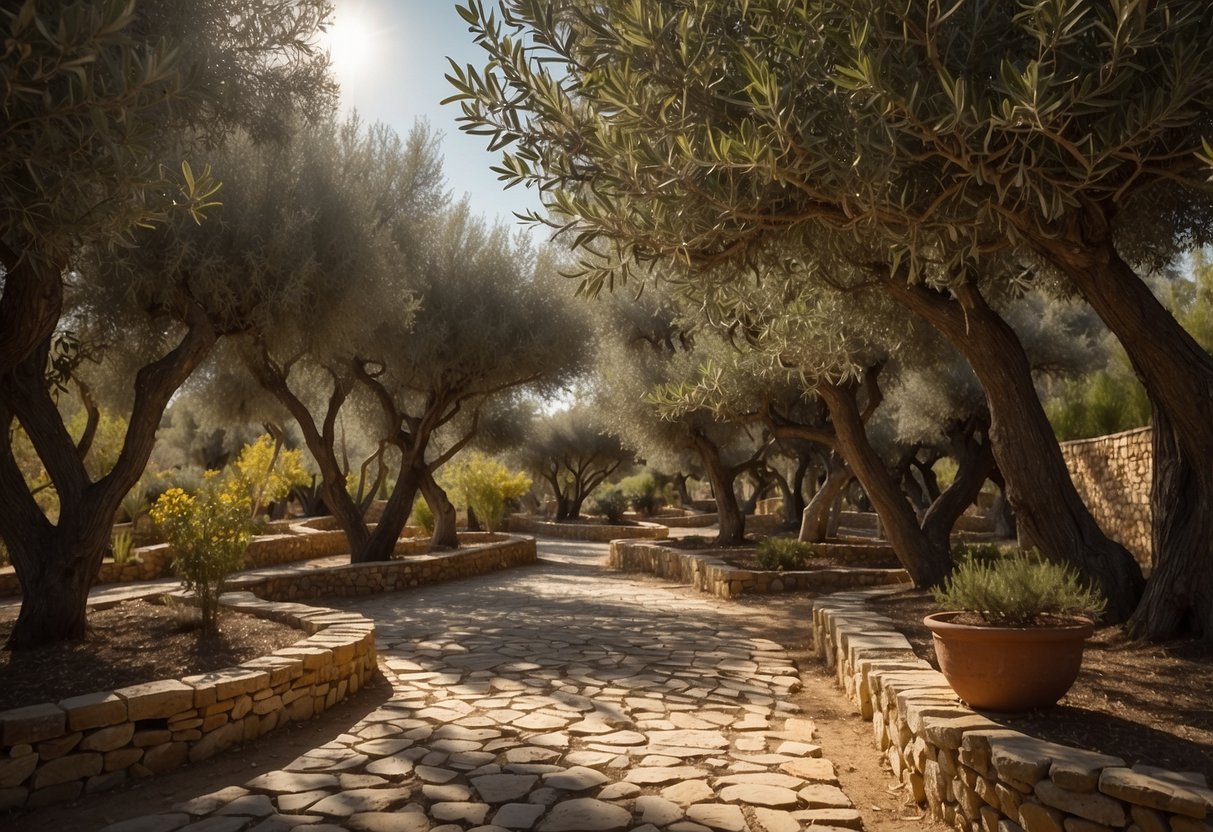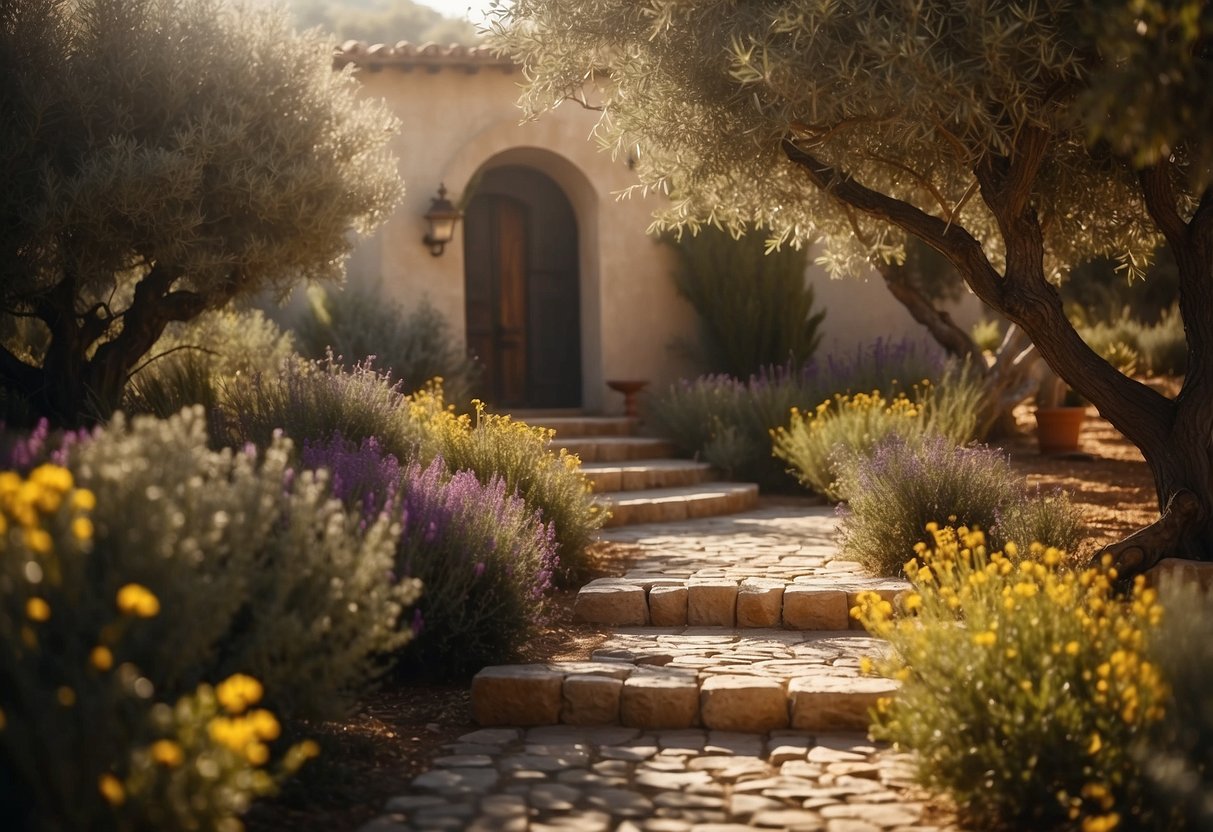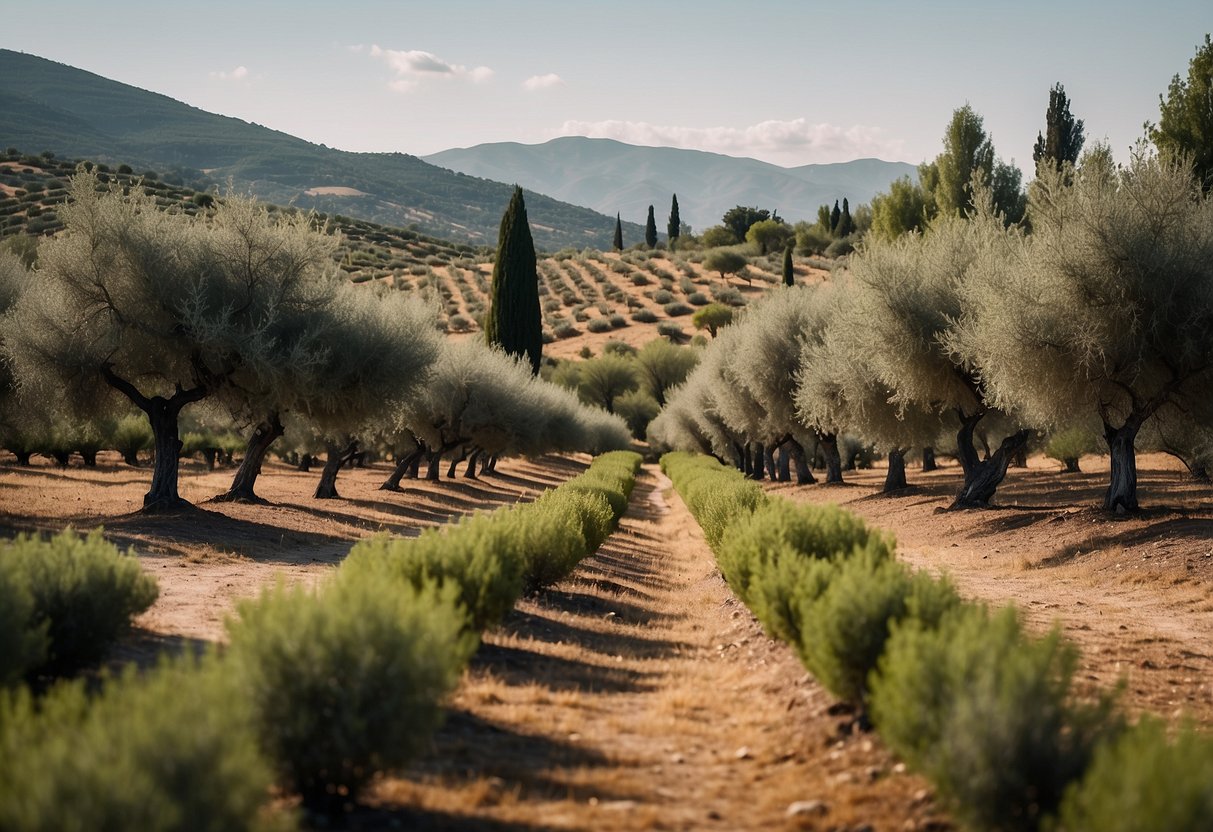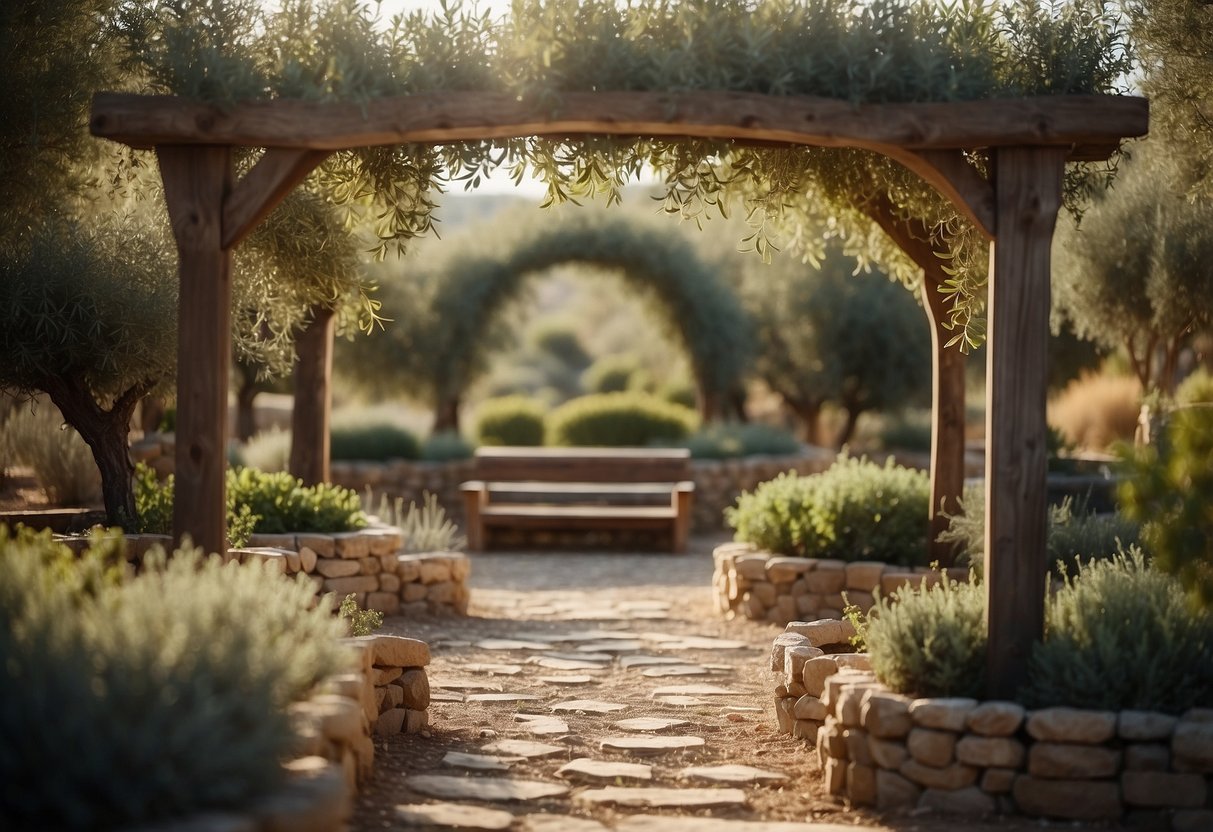Olive Tree Garden Ideas: Transform Your Outdoor Space
Are you looking to add a touch of Mediterranean charm to your garden? Olive trees can be a beautiful and functional addition to your outdoor space. Their silvery foliage and gnarled trunks create a timeless look that fits well with many garden styles.

By incorporating olive trees, you can achieve a stunning and unique garden that stands out. Whether you have a large yard or a small balcony, there are plenty of creative ways to use olive trees in your landscape. From potted plants to natural privacy screens, the possibilities are endless.
1) Mediterranean Pathway

Creating a Mediterranean pathway in your garden adds both beauty and structure. To get started, think about using natural materials like gravel or stone. You can line the path with plants common to Mediterranean gardens, such as lavender and rosemary.
Adding an olive tree along the pathway can enhance the Mediterranean feel. Its gray-green leaves provide a stunning contrast to a dark pathway, making your garden look inviting and elegant.
2) Potted Olive Trees

Potted olive trees are a great idea for small spaces or patios. They can thrive in containers with proper care. Make sure to choose a pot with good drainage to prevent waterlogging.
Water your potted olive tree when the top 1-2 inches of soil are dry. In hot months, this might be every few days, while in cooler times, every couple of weeks is enough (Olive Trees in Pots).
Place your olive tree in a spot with at least six hours of full sun each day. Avoid plastic pots as they retain more water, which can be harmful (Container Grown Olive Trees).
3) Herb Spiral with Olive Tree Centerpiece

Imagine having a beautiful herb spiral with an olive tree right in the center.
Start by marking the center where the olive tree will go.
Build your spiral around it using bricks, stones, or wooden logs.
Plant herbs like rosemary, oregano, and thyme near the olive tree for a Mediterranean feel.
Find more details on creating a herb spiral garden.
4) Rustic Stone Planters

Rustic stone planters can add charm to your olive tree garden. They are durable and complement the natural look of olive trees. You can build stone planters yourself using a simple mix of sand and cement.
Choosing the right stones is key. Look for ones that match your garden style. Use the planters to define garden spaces or create focal points.
5) Olive Tree Topiary

Olive tree topiaries add a touch of elegance to any garden. You can shape your trees into simple forms like pom-poms or try more artistic designs like spirals and bird shapes.
When pruning an olive topiary, start by removing suckers at the base and trimming any unwanted branches. This helps your tree maintain its beautiful form.
Consider placing olive tree topiaries on patios or in living rooms. They not only serve as stunning focal points but also create a calming atmosphere. It’s a delightful way to enhance your space.
6) Zen Garden with Olive Tree Accent

Combining an olive tree with a zen garden creates a unique and peaceful space. The olive tree’s gray-green leaves offer a soft contrast to the raked gravel or white pebbles typical in zen gardens.
Place the olive tree near a stone pathway or a small bridge. It provides a focal point and adds natural beauty.
You can also plant mini olive trees in pots around the garden. This setup combines the calm of a zen garden with the timeless elegance of olive trees, making your garden a true sanctuary.
For more ideas, check out these zen garden inspirations.
7) Modern Minimalist Olive Grove

A modern minimalist olive grove focuses on clean lines and simple structures. Start by planting evenly spaced olive trees in straight rows. This creates a sleek, organized look.
Use materials like concrete or gravel for pathways. These materials complement the trees’ earthy tones.
Incorporate minimalist seating areas with simple benches or chairs. This allows you to sit and appreciate the beauty of your grove. For more ideas, check out these landscapes with olive trees.
8) Mediterranean-themed Courtyard

Creating a Mediterranean-themed courtyard can make your outdoor space feel like a vacation spot.
Use an olive tree as a focal point. Its silvery leaves and twisted trunk add charm.
Incorporate natural materials like terracotta tiles and gravel paths. These complement the trees beautifully.
Add comfortable seating areas. Use stone benches or wooden chairs with colorful cushions.
Plant aromatic herbs like lavender and rosemary around the edges. They thrive in Mediterranean climates and add lovely scents.
Consider installing a small water feature. A simple fountain can add tranquility and enhance the Mediterranean vibe.
9) Patio Herb Garden with Olive Trees

Pairing olive trees with herbs on your patio is a great way to create a Mediterranean vibe. Olive trees do well in pots and provide a lovely green backdrop.
Combine the olive trees with herbs like rosemary, sage, and thyme to add both beauty and utility. You can use terracotta pots to give it a more authentic feel.
You can also include plants like lavender to enhance the fragrance and appeal. This setup offers a relaxing, lush, and practical garden space for any outdoor area.
10) Raised Bed Olive Arbor

A raised bed olive arbor can be a beautiful addition to your garden. By planting olive trees in raised beds, you ensure they receive ample sunlight and drainage. This setup also makes it easy to manage their growth and health.
You can add a touch of Mediterranean charm to your space with these trees. They look stunning and provide a lovely, airy canopy overhead. Enjoy the serene atmosphere as you relax under your raised bed olive arbor.
Choosing the Right Olive Tree Variety

Selecting the best olive tree variety depends on your local climate and the soil type in your garden. Each factor can influence the growth and health of your olive trees.
Climate Considerations
Olive trees thrive in warm, dry climates. They are best suited for Mediterranean-like environments with hot summers and mild winters. If your area has harsh winters or high humidity, you might need to consider hardier varieties.
In cooler climates, look for cold-tolerant species such as the Arbequina or Koroneiki. These varieties can handle occasional frost and lower temperatures better than others. If you live in a coastal area with salty air, Picual olive trees are a great choice. They adapt well to different environments, including coastal conditions.
Soil Requirements
Olive trees prefer well-drained, sandy soil with a pH level between 5.5 and 7.5. They do not thrive in waterlogged soils or heavy clay. If your garden has poor drainage, consider raised beds or amend the soil with sand and organic matter to improve its structure.
Before planting, test your soil’s pH. You can do this with a home testing kit or by sending a sample to a lab. If your soil is too acidic, add lime to raise the pH. For alkaline soils, sulfur can help lower the pH.
Choose varieties such as Manzanillo or Kalamata if you have sandy soil, as they grow well in these conditions. For gardens with a mix of soil types, the versatile Picual tree can adapt to various conditions, making it a reliable choice.
Planting and Care Tips

Caring for olive trees involves making sure they are watered correctly, pruned properly, and fertilized to support healthy growth. Here are essential tips to guide you through each aspect.
Watering Needs
Olive trees require well-drained soil and should not be overwatered. Ensure the pot or planting area has good drainage to prevent roots from sitting in water. Water the tree when the top 2 inches of soil feel dry.
For newly planted trees, water them deeply once a week. Mature trees need less frequent watering, only about every two to four weeks, depending on rainfall and humidity.
In hotter months, increase watering to prevent the soil from drying out completely. Tip: Mulching around the base helps retain moisture.
Pruning Tips
Pruning your olive tree is crucial to maintain its shape and health. The best time to prune is late winter to early spring, before new growth starts.
Remove any dead, diseased, or damaged branches. Trim back shoots that cross each other to increase light and air circulation. Focus on keeping the center of the tree open to avoid overcrowding.
For trees grown for fruit, prune to maintain height and shape, allowing more energy to go into fruit production. Use clean, sharp tools to make clean cuts.
Fertilization Guide
Feed your olive tree with a balanced fertilizer in early spring. Use a fertilizer with an N-P-K ratio of about 10-10-10 or 20-20-20.
Apply it according to the package instructions, usually around the drip line of the tree. Repeat the feeding twice more during the growing season, in mid-summer and early fall.
If your tree shows signs of nutrient deficiencies, such as yellowing leaves, consider a foliar spray with micronutrients. Avoid over-fertilizing, as this can lead to excessive foliage growth at the expense of fruit production.
Design Ideas for Olive Tree Gardens

Olive tree gardens can transform your space with a touch of Mediterranean charm or a sleek modern vibe. Here are two design approaches to consider:
Mediterranean Style
A Mediterranean garden is perfect if you love a relaxed and timeless look. Incorporate terra cotta pots, gravel pathways, and stone benches. Olive trees with their silvery leaves pair beautifully with lavender, rosemary, and santolina.
Use wicker baskets for small olive trees to add a rustic feel. Place climbing vines like jasmine next to your olive trees for additional texture. A fountain or a small water feature could complete the serene atmosphere, providing a calming backdrop to your outdoor space.
Modern Minimalist Approach
For a clean and contemporary look, go minimalist. Use simple geometric shapes and neutral colors like grey, white, and black. Opt for sleek containers in materials such as concrete or metal for your olive trees.
Arrange your trees in straight lines or symmetrical patterns to emphasize order and simplicity. Cloud pruning techniques can give your trees a stylish, sculptural appearance. To enhance the modern aesthetic, pair the trees with gravel beds or simple lawn areas. Consider adding subtle lighting to highlight the trees at night.
By selecting the right design elements, your olive tree garden can match your personal style and enhance your outdoor space. For more inspiration, take a look at these genius garden ideas and expert landscape tips.







